8 Academic Advising
“Never take advice about never taking advice. That is an old vice of men – to dish it out without being able to take it”.
~Criss Jami
Academic Advising is structured differently in every college or university, but the practical mission behind academic advising is to assists students in making informed decisions based on the student’s goals and values. Academic advisors help students develop educational plans by discussing life and career goals, selecting classes towards that goal, interpreting degree requirements, placement test scores, school policies and procedures.
According to Light, R.J. (2001), Academic Advising “may be the single more underestimated characteristic of a successful college experience” and at Chemeketa academic advising is a free, valuable resource for all students. Students who meet with an advisor and develop a relationship with them often feel more empowered to make informed decisions about their future. In some colleges advising is not necessary to register for classes, in other colleges such as in Chemeketa advising is required until the students successfully completes 30 or more credits at the 100 level or higher. However it is suggested to check in with an advisor even after 30 credits. If the student develops a relationship with their advisor, they are more likely to visit them, check in with them and get help with academic questions. Regardless of the reasons why a student visits an advisor, academic advising can help you stay on the path towards your goal and this is especially true when considering changes in the college, degrees, or in the job market.
At Chemeketa you are required to meet with an advisor until you successfully complete 30 credits at the 100 level or higher. During this period you meet with your advisor to discuss your plans. Your advisor will be assigned based upon your stated interest at your first advising meeting. Maybe you are a student that knows what major or program you want to study for, or maybe you are undecided? But what if you change your major? What if you decide to transfer to a 4 year college? What if you first choice of transfer changes? All of those decisions you make in your college career have different paths and therefore they need different educational plans.
Think of academic advising from a benefit/opportunity cost analysis. If you are investing in your education time and money, why not make sure that you are in the right track to graduation and completion of your goals? The return on 30 minutes spent in meeting an academic advisor might save you more money and time in the future. Unfortunately many students tend to self-advise themselves and that could mean taking more time to graduate or decreasing the possibilities of achieving a college degree.
Academic Advising as a Shared Responsibility
A common misconception about academic advising is that the full responsibility of a student’s academic choices fall on the advisor. It is important to remember that academic advising is a shared responsibility between the advisor and the student. For example, if a student creates an educational plan along with an advisor to obtain an Associates of Arts Oregon Transfer (AAOT) with the intention of majoring in Psychology and transfer to Western, but the student decides to switch to Nursing and apply for the Chemeketa’s Nursing Program, the educational plan might look different from the original educational plan.
It is at that point that the responsibility of the student comes in play. It is always the student’s responsibility to inform their academic advisor of their decisions, especially if those mean changing educational paths. If the student chooses to self advise, then it is the student’s responsibility to accept their decisions. Remember that advisors will help you clarify and develop realistic educational goals as long as the student keeps the lines of communication open and the relationship with the advisor ongoing. In addition, many advisors try to keep up with always changing requirements for colleges, universities, program, and even financial aid procedures, but it can be challenging. Advisors try to always be on the search for accurate information about the suggestions they make to the students, but it is also the responsibility of the student to ask how they advisor got to the information. It is always good to know if for example a student is trying to transfer to a 4 year college, and the advisor suggests the student to start connecting with an advisor at the college they wish to transfer, the suggestion should not be taken lightly. Remember two academic advisors one in the institution you are taking classes at and one in the institution you are going to transfer might make your transition to that college smoother and with less bumps.
Making an Advising Appointment
Every college that you attend or hope to attend have a different way to schedule an advising appointment. Some colleges even have drop in advising dates. At Chemeketa drop in advising sessions happen the first few days of every term, otherwise they need to be scheduled through My.Chemeketa.
Advising appointments can be face to face and on the phone in case the student cannot make it to a Chemeketa location. Also there are evenings and weekend appointments for students who schedules are tight or have many responsibilities which makes it hard for them to meet an advisor during the week between the hours of 8 am to 5 pm.
For Chemeketa, students have to log into My.Chemeketa and go to the “Services” tab, and click on “Advising” and hover to the right and click on the academic advising (Salem, Yamhill, Brooks, Polk, Woodburn or High School Partnerships).
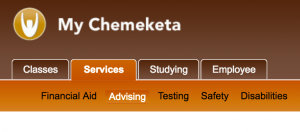
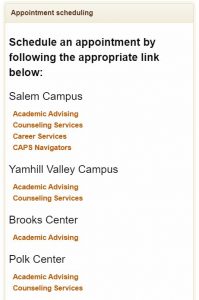
After clicking on Academic Advising for Salem, for example, then you can choose from the menu, first term advising (if this is your fist term at Chemeketa), Next Term Advising (second term and beyond), General Advising (for any advising at any point even after completing 30 credits at Chemeketa).

After, you can click on your advisor and choose a date and time convenient to you. If you do not have an assigned advisor, cannot remember your assigned advisor or have no preference on who you meet with, you can click on “No preference”.

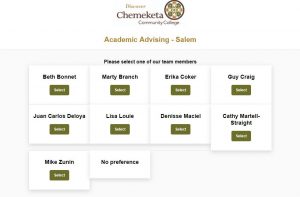
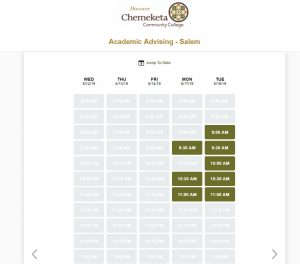
When you have decided on a date and time, just click on the time you would like to meet your advisor, and fill out the form that follows with as much details as you can. That way your advisor can have the info needed to help you.
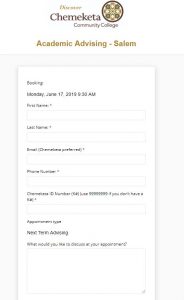
Degree Works
Degree Works is a tool available to Chemeketa students and at other universities if they have it available. This web-tool can help you check your progress towards the completion of your degree. Degree works is available via My.Chemeketa under the Grades and Transcript tab to the right. The main page of Degree Works will always default to your current degree, major or concentration as you have it listed on your records. If your degree, major or concentration is not correct, then talk to your advisor and discuss changing your degree, major or concentration officially.
There are many tools that you can use, the first one is tracking the completion of your degree. You can do that by looking at the default page. Under your info, you will find a legend. The legend helps you understand how to read each icon next to the classes listed below.
Works Cited
Advising and Retention Quotes. NACADA, www.nacada.ksu.edu/Resources/Clearinghouse/View-Articles/Advising-and-Retention-Quotes.aspx.
Licenses and Attributions
Original chapter work is attributed to Grecia Garcia and edited by Ashley Duran.

